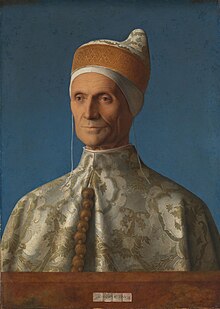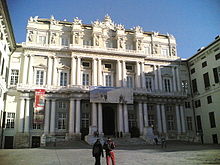Doge
Doge [ˈdoːʒə] , from Venetian : Doxe [ˈdoːze] , was the title of elected chief in a number of Italian republics of the Middle Ages and early modern times . The title of a Doge's wife is Dogaressa . The office, term of office, or dignity of a doge is called a dogat .
Word meaning
The word doge is an Italian dialect word. The name is derived from the Latin dux , a term used in Roman administration: From the 4th century onwards, dux was the name of the highest military commander of a border province among the Romans , while in late antiquity they usually had a Magister militum in the areas belonging to the Byzantine Empire ( Army Master ) was superior. In modern standard Italian, a distinction is made between doge and duce . Many European languages, e.g. B. English, French and Spanish adopted the word doge to denote this specifically Italian form of rule, while in German doge is often misleadingly translated as duke .
Venice, Genoa, Senarica
The most powerful doges (Venetian: doxe , can ) had the Republic of Venice (see: Doge of Venice ) . Although their powers were severely restricted by the Constitution of the Republic of Venice , they were elected for life. In the early days of the Republic, the Doge was still an unlimited ruler, but his disempowerment began at the beginning of the 11th century, and at the end of the 13th century he was only a strictly supervised representative of the state. In the Republic of Venice, the residents of Murano also elected their own doge and the head of the Venetian community of San Nicolò also held the title Dose dei Nicoloti .
Venice's main rival, the Republic of Genoa , initially had dual power at the head of the state , then - like most other northern Italian cities - a temporarily elected Podestà , then from 1099 a Capitano del popolo , from 1339 (for the first time with Simone Boccanegra ) one elected for life Doges and finally, from 1528 until the Napoleonic occupation in 1797, Doges were elected for a limited period (only for two years at a time).
The territories of these trading republics were rather small, but their trading empires stretched far into Europe, Africa and Asia.
Senarica , another insignificant republic in Abruzzo on the Italian Adriatic compared to Venice and Genoa , also elected its Doge (probably annually) from 1343 until the annexation by the Neapolitan Kingdom of Sicily in 1797.
Customs of the Doges of Venice
The doge cap was the characteristic piece of clothing of the Doge of Venice, which he also wore in his coat of arms instead of a crown. The cloak in the form of a mozzetta was made of brocade fabric , often made of ermine fur as a symbol of rulership , and the undercoat was often trimmed with lush lynx fur .
The graves of most of the Doges of Venice are in the Church of San Zanipolo .
See also
Web links
Individual evidence
-
↑ Commons : Images of Doges from Venice with ermine fur - collection of images
-
↑ Commons : Images of Doges from Venice with lynx fur - Collection of images



